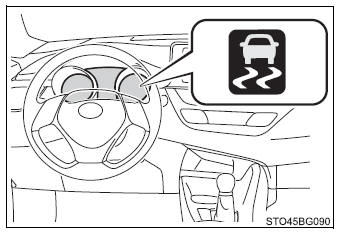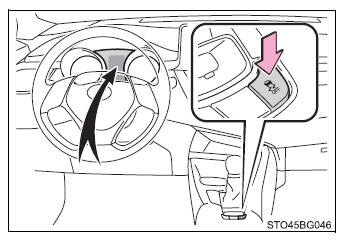Toyota CH-R Owners Manual: Driving assist systems
To keep driving safety and performance, the following systems operate automatically in response to various driving situations.
Be aware, however, that these systems are supplementary and should not be relied upon too heavily when operating the vehicle.
ABS (Anti-lock Brake System)
Helps to prevent wheel lock when the brakes are applied suddenly, or if the brakes are applied while driving on a slippery road surface
Brake assist
Generates an increased level of braking force after the brake pedal is depressed when the system detects a panic stop situation
VSC (Vehicle Stability Control)
Helps the driver to control skidding when swerving suddenly or turning on slippery road surfaces
Enhanced VSC (Enhanced Vehicle Stability Control)
Provides cooperative control of the ABS, TRAC, VSC and EPS.
Helps to maintain directional stability when swerving on slippery road surfaces by controlling steering performance
TRAC (Traction Control)
Helps to maintain drive power and prevent the drive wheels from spinning when starting the vehicle or accelerating on slippery roads
ACA (Active Cornering Assist)
Helps to prevent the vehicle from drifting to the outer side by performing inner wheel brake control when attempting to accelerate while turning.
Hill-start assist control
Helps to reduce the backward movement of the vehicle when starting on an uphill
EPS (Electric Power Steering)
Employs an electric motor to reduce the amount of effort needed to turn the steering wheel.
When the TRAC/VSC systems are operating
The slip indicator light will flash while the TRAC/VSC systems are operating.

Disabling the TRAC system
If the vehicle gets stuck in mud, dirt or snow, the TRAC system may reduce power
from the engine to the wheels. Pressing
 to
turn the system off may make it easier for you to rock the vehicle in order to free
it.
to
turn the system off may make it easier for you to rock the vehicle in order to free
it.
To turn the TRAC system off, quickly press and release .
.
A message will be shown on the multi-information display.
Press
 again
to turn the system back on.
again
to turn the system back on.

■Turning off both TRAC and VSC systems
To turn the TRAC and VSC systems off, press and hold
 for
more than 3 seconds while the vehicle is stopped.
for
more than 3 seconds while the vehicle is stopped.
The VSC off indicator light will come on and the message will be shown on the multi-information display.*
*: On vehicles with pre-collision system, pre-collision brake assist and precollision braking will also be disabled. The PCS warning light will come on and the message will be shown on the multi-information display.
Press
 again
to turn the systems back on.
again
to turn the systems back on.
■When the message is displayed on the multi-information display showing
that TRAC has been disabled even if
 has
not been pressed TRAC cannot be operated. Contact your Toyota dealer.
has
not been pressed TRAC cannot be operated. Contact your Toyota dealer.
■Sounds and vibrations caused by the ABS, brake assist, VSC, TRAC and hill-start assist control systems
- A sound may be heard from the engine compartment when the brake pedal is depressed repeatedly, when the engine is started or just after the vehicle begins to move. This sound does not indicate that a malfunction has occurred in any of these systems.
- Any of the following conditions may occur when the above systems are operating.
None of these indicates that a malfunction has occurred.
- Vibrations may be felt through the vehicle body and steering.
- A motor sound may be heard also after the vehicle comes to a stop.
- The brake pedal may pulsate slightly after the ABS is activated.
- The brake pedal may move down slightly after the ABS is activated.
■Sounds and vibrations caused by the ACA system Operation sounds and vibrations from the brake system may occur when the ACA system is operating. However, none of these indicates a malfunction.
■EPS operation sound When the steering wheel is operated, a motor sound (whirring sound) may be heard. This does not indicate a malfunction.
■Automatic reactivation of TRAC and VSC systems After turning the TRAC and VSC systems off, the systems will be automatically re-enabled in the following situations:
- Vehicles without a smart key system: When the engine switch is turned to
the "LOCK" position
Vehicles with a smart key system: When the engine switch is turned off - If only the TRAC system is turned off, the TRAC will turn on when vehicle
speed increases
If both the TRAC and VSC systems are turned off, automatic re-enabling will not occur when vehicle speed increases.
■Operating conditions of ACA The system operates when the following occurs:
- TRAC/VSC can operate
- The driver is attempting to accelerate while turning
- The system detects that the vehicle is drifting to the outer side
- The brake pedal is released
■Reduced effectiveness of the EPS system The effectiveness of the EPS system is reduced to prevent the system from overheating when there is frequent steering input over an extended period of time. The steering wheel may feel heavy as a result. Should this occur, refrain from excessive steering input or stop the vehicle and turn the engine off. The EPS system should return to normal within 10 minutes.
■Operating conditions of hill-start assist control When the following four conditions are met, the hill-start assist control will operate:
-
The shift lever is in a position other than P or N (when starting off forward/ backward on an upward incline).
-
The vehicle is stopped.
-
The accelerator pedal is not depressed.
-
The parking brake is not engaged.
■Automatic system cancelation of hill-start assist control The hill-start assist control will turn off in any of the following situations:
-
The shift lever is shifted to P or N.
-
The accelerator pedal is depressed.
-
The parking brake is engaged.
-
2 seconds at maximum elapsed after the brake pedal is released.
■The ABS does not operate effectively when
- The limits of tire gripping performance have been exceeded (such as excessively worn tires on a snow covered road).
- The vehicle hydroplanes while driving at high speed on wet or slick roads.
■Stopping distance when the ABS is operating may exceed that of normal conditions The ABS is not designed to shorten the vehicle's stopping distance. Always maintain a safe distance from the vehicle in front of you, especially in the following situations:
- When driving on dirt, gravel or snow-covered roads
- When driving with tire chains
- When driving over bumps in the road
- When driving over roads with potholes or uneven surfaces
■TRAC/VSC may not operate effectively when Directional control and power may not be achievable while driving on slippery road surfaces, even if the TRAC/VSC system is operating.
Drive the vehicle carefully in conditions where stability and power may be lost.
■ACA does not operate effectively when
- Do not overly rely on ACA. ACA may not operate effectively when accelerating down slopes or driving on slippery road surfaces.
- When ACA frequently operates, ACA may temporarily stop operating to ensure proper operation of the brakes, TRAC and VSC.
■Hill- start assist control does not operate effectively when
- Do not overly rely on hill-start assist control. Hill-start assist control may not operate effectively on steep inclines and roads covered with ice.
- Unlike the parking brake, hill-start assist control is not intended to hold the vehicle stationary for an extended period of time. Do not attempt to use hill-start assist control to hold the vehicle on an incline, as doing so may lead to an accident.
■When the TRAC/VSC is activated The slip indicator light flashes. Always drive carefully. Reckless driving may cause an accident. Exercise particular care when the indicator light flashes.
■When the TRAC/VSC systems are turned off Be especially careful and drive at a speed appropriate to the road conditions.
As these are the systems to help ensure vehicle stability and driving force, do not turn the TRAC/VSC systems off unless necessary.
■Replacing tires Make sure that all tires are of the specified size, brand, tread pattern and total load capacity. In addition, make sure that the tires are inflated to the recommended tire inflation pressure level.
The ABS, TRAC and VSC systems will not function correctly if different tires are installed on the vehicle.
Contact your Toyota dealer for further information when replacing tires or wheels.
■Handling of tires and the suspension Using tires with any kind of problem or modifying the suspension will affect the driving assist systems, and may cause a system to malfunction.
 RCTA function
RCTA function
The RCTA functions when your vehicle is in reverse. It can detect other vehicles
approaching from the right or left rear of the vehicle. It uses radar sensors to
alert the driver of the other vehi ...
 Driving tips
Driving tips
Winter driving tips
Carry out the necessary preparations and inspections before driving
the vehicle in winter. Always drive the vehicle in a manner appropriate to the prevailing
weather condition ...
Other materials:
Toyota CH-R Service Manual > Pre-collision System: Terminals Of Ecu
TERMINALS OF ECU
CHECK MILLIMETER WAVE RADAR SENSOR
(a) Measure the voltage and resistance according to the value(s) in the table
below.
HINT:
If the result is not as specified, there may be a malfunction on the wire harness
side.
Terminal No. (Symbol)
Wiring Color
...
Toyota CH-R Service Manual > Continuously Variable Transaxle System: Pressure Control Solenoid "J" Performance or Stuck Off (P2820)
DESCRIPTION
According to current control by the ECM, the shift solenoid valve SLP controls
primary pulley pressure in accordance with the requested gear ratio to perform gear
ratio changes.
DTC No.
Detection Item
DTC Detection Condition
Trouble Area
...
Toyota C-HR (AX20) 2023-2026 Owner's Manual
Toyota CH-R Owners Manual
- For safety and security
- Instrument cluster
- Operation of each component
- Driving
- Interior features
- Maintenance and care
- When trouble arises
- Vehicle specifications
- For owners
Toyota CH-R Service Manual
- Introduction
- Maintenance
- Audio / Video
- Cellular Communication
- Navigation / Multi Info Display
- Park Assist / Monitoring
- Brake (front)
- Brake (rear)
- Brake Control / Dynamic Control Systems
- Brake System (other)
- Parking Brake
- Axle And Differential
- Drive Shaft / Propeller Shaft
- K114 Cvt
- 3zr-fae Battery / Charging
- Networking
- Power Distribution
- Power Assist Systems
- Steering Column
- Steering Gear / Linkage
- Alignment / Handling Diagnosis
- Front Suspension
- Rear Suspension
- Tire / Wheel
- Tire Pressure Monitoring
- Door / Hatch
- Exterior Panels / Trim
- Horn
- Lighting (ext)
- Mirror (ext)
- Window / Glass
- Wiper / Washer
- Door Lock
- Heating / Air Conditioning
- Interior Panels / Trim
- Lighting (int)
- Meter / Gauge / Display
- Mirror (int)
- Power Outlets (int)
- Pre-collision
- Seat
- Seat Belt
- Supplemental Restraint Systems
- Theft Deterrent / Keyless Entry
0.0094
